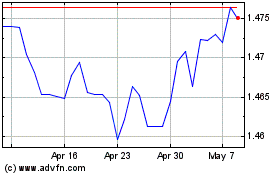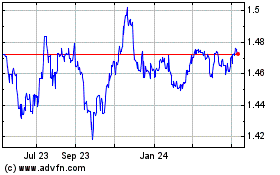German Trade Surplus Falls On Imports; Bundesbank Raises Growth Outlook
June 09 2017 - 3:39AM
RTTF2
Germany's trade surplus decreased in April as imports growth
exceeded exports, data published by Destatis revealed Friday.
Elsewhere, Bundesbank upgraded its growth projections citing a
strong labor market, consumption and government spending and
investment.
Exports grew 0.9 percent month-on-month in April, faster than
the 0.4 percent increase seen in March and the 0.3 percent rise
economists had expected.
However, the growth in imports eased from March, the pace of
expansion exceeded the improvement in exports.
Imports gained 1.2 percent in April after rising 2.1 percent in
March. Nonetheless, imports were forecast to fall 0.5 percent.
Consequently, the trade surplus fell to a seasonally adjusted
EUR 19.8 billion from EUR 19.9 billion in the previous month.
On a yearly basis, exports declined by an unadjusted 2.9
percent, in contrast to March's 10.8 percent increase. At the same
time, imports advanced 5.4 percent, but slower than the 14.8
percent rise seen in March.
The current account, which measures the flow of goods, services
and investment, showed a surplus of EUR 15.1 billion compared to a
EUR 28.1 billion surplus in April 2016.
German data continue to be positive, with a decent rise in
exports in April, Jessica Hinds, an economist at Capital Economics,
said.
The health of exports supports the assessment that German GDP
will expand strongly this year, by about 2.5 percent, the economist
added.
Bundesbank upgraded its growth projections for this year, 2018
and 2019 by a percentage point.
The bank forecast the largest euro area economy to grow 1.9
percent this year, 1.7 percent next year and 1.6 percent in
2019.
Bundesbank raised its inflation outlook for this year, while
downgrading the projections for 2018 and 2019.
The bank said that the positive outlook is based on a broad,
strong upward movement, adding that the supply shortage on the
labor market is likely to become increasingly noticeable.
The bank forecast 1.5 percent inflation in the current year,
which was revised up from 1.4 percent. The outlook for 2018 was
lowered to 1.4 percent from 1.7 percent and the 2019 forecast to
1.8 percent from 1.9 percent.
Euro vs CAD (FX:EURCAD)
Forex Chart
From Mar 2024 to Apr 2024

Euro vs CAD (FX:EURCAD)
Forex Chart
From Apr 2023 to Apr 2024
